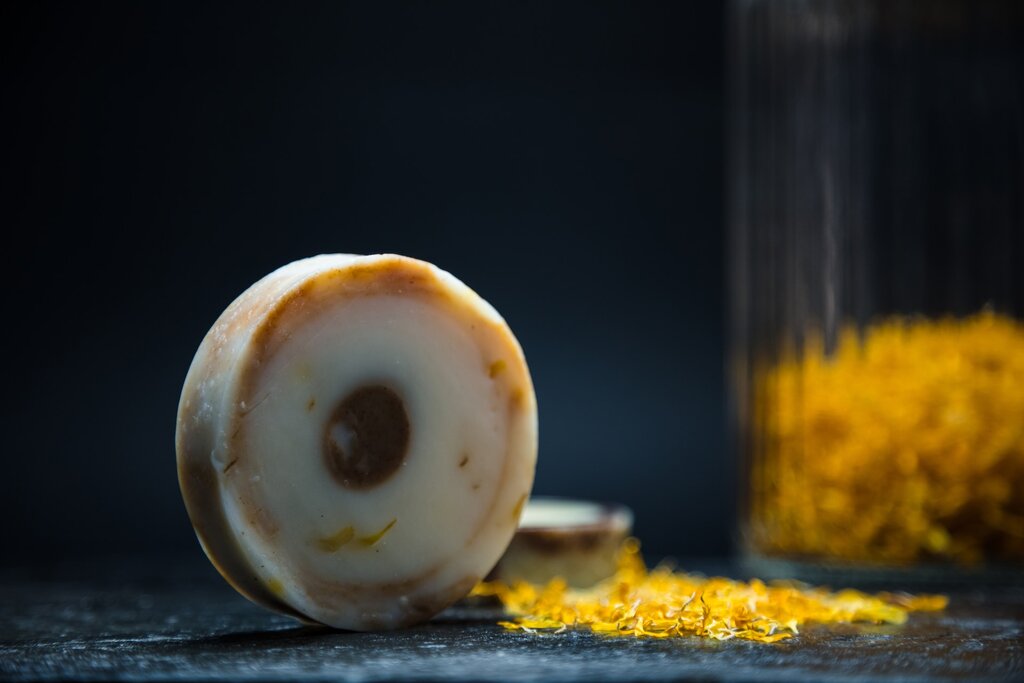DIY Turmeric Soap Recipe for Glowing, Acne-Free Skin

Are you looking for an all-natural way to achieve a glowing, acne-free complexion? Look no further than this DIY Turmeric Soap recipe! Turmeric is known for its anti-inflammatory and antioxidant properties.
It can also help reduce the look of blemishes and make your skin look brighter. Plus, making your soap at home is fun and easy - so why not try it? Follow this simple recipe to start reaping the benefits of turmeric today!
Benefits of Using Turmeric Soap for Your Skin
Turmeric soap can do wonders for your skin! This natural remedy has anti-inflammatory and antibacterial properties, making it ideal for treating acne. Additionally, turmeric soap can help to brighten your skin and give it a healthy glow.
Turmeric soap is also excellent for those with sensitive skin. Its gentle ingredients won't irritate your skin, and its soothing properties will leave it feeling soft and silky.
If you're looking for an all-natural way to achieve beautiful, clear skin, look no further than turmeric soap!
What You'll Need to Make Your Own Turmeric Soap:
- 1 cup of soap flakes
- 1/2 cup of boiling water
- One tablespoon of turmeric powder
- A soap mold
- Optional: 1 teaspoon of honey, milk, or olive oil
Making turmeric soap is easy and requires only a few ingredients you may already have. You only need 1 cup of soap flakes, 1/2 cup of boiling water, one tablespoon of turmeric powder, and a soap mold.
Optional ingredients include one teaspoon of honey, milk, or olive oil. Mix the ingredients and pour them into the mold. Let the soap sit for 24 hours before use.
Step-by-Step Guide to Making Turmeric Soap at Home
Turmeric has been used in Indian cultures for centuries as a natural beauty remedy. The spice is anti-inflammatory and antioxidant, making it great for acne-prone skin. When used topically, turmeric can help to soothe redness and inflammation and brighten the skin.
Soapmaking is a fun and easy DIY project that anyone can do at home. You can create a beautiful and moisturizing soap bar with simple ingredients.
This turmeric soap recipe is perfect for those with acne-prone or sensitive skin. Adding turmeric will help calm the skin, while honey and coconut milk hydrate and nourish.
To make this turmeric soap recipe, you will need the following:
- 1 cup coconut oil
- 1 cup olive oil
- 1 cup distilled water
- ¼ cup honey
- Four tablespoons of grated turmeric root (or one teaspoon of ground turmeric)
- Two tablespoons sodium hydroxide (lye)
- Optional: 1 teaspoon of essential oil for fragrance (we recommend lavender or geranium)
WARNING: Do not attempt this recipe without proper safety gear! Lye is a caustic substance, and contact with skin can cause burns. Always wear gloves, long sleeves, and eye protection when working with lye.
- Begin by measuring out your coconut oil, olive oil, distilled water, and honey in separate containers.
- Measure the lye into a heat-safe container and slowly pour in the distilled water while stirring with a non-metallic spoon. Do not breathe in the fumes or get it on your skin! Set aside to cool.
- In a double boiler, melt the coconut and olive oils until they are liquid.
- Once both oils have fully melted and cooled to around 100°F, add the grated turmeric root or ground turmeric powder and stir to combine. Doing this at this temperature ensures that the turmeric will be evenly distributed throughout the soap mixture.
- When all of your ingredients are ready, slowly add in the lye/water mixture while stirring continuously with a non-metallic spoon for about 3 minutes or until it reaches "trace" (the point where you can see trails remain when you lift your spoon). This is what helps create a nice soap bar, so make sure to take your time with this step!
- If desired, add one teaspoon of essential oil for fragrance (we recommend lavender or geranium). Stir to combine.
- Pour the soap mixture into a lightly greased mold and let it sit for 24-48 hours until cooled and hardened.
- Once your soap has cooled and hardened, remove it from the mold and cut it into bars using a sharp knife. Allow the bars to air dry for at least four weeks before using them.
And that's it! You've just made your very own homemade turmeric soap! Enjoy in the shower or as a hand wash – your skin will thank you!
Tips for Choosing the Best Ingredients for Your Turmeric Soap Recipe
Regarding turmeric soap recipes, the best ingredients will benefit your skin the most.
Here are some tips for choosing the best ingredients for your recipe:
- Opt for a natural, organic turmeric powder. This will ensure you get the highest quality turmeric with the most skin benefits.
- Choose a carrier oil that's suitable for your skin type. If you have oily skin, consider using grapeseed oil or jojoba oil. For dry skin, try cocoa butter or shea butter. And for sensitive skin, almond oil or olive oil are good choices.
- Add other skin-loving ingredients like honey, aloe vera gel, or essential oils. These will help boost the efficacy of your soap and further nourish your skin.
- Use only high-quality, food-grade ingredients. This will ensure that your soap is both safe and effective.
- Remember to test your recipe before you make a large batch of soap. This will help you tweak the ingredients until you get the perfect soap.
How to Customize Your Turmeric Soap Recipe for Your Skin Type
Turmeric Soap is an excellent choice for those looking to improve their skin health. This vitamin and mineral-rich soap can treat acne, eczema, psoriasis, and other skin conditions. Turmeric Soap can also be customized to fit your specific skin type.
For example, add more oil to the recipe if you have dry skin. If you have oily skin, you can add more clay. And if you have sensitive skin, you can add more glycerin.
You can also adjust the essential oils to suit your skin type. For dry skin, rosemary, sandalwood, and lavender are all good choices. Tea trees, lemon, and peppermint are excellent choices for oily skin. And for sensitive skin, chamomile, and geranium are both great additions.
Finally, you can add other ingredients to customize your turmeric soap recipe further. Honey is an excellent addition for its moisturizing properties, while oatmeal is best suited to exfoliating properties.
You can create a soap that will improve your overall complexion by customizing your Turmeric Soap recipe with the right ingredients according to your skin type.
How to Store and Use Your Homemade Turmeric Soap
Assuming you understand how to make soap, we will move on to the specifics of adding turmeric.
Here are some tips on how to store and use your homemade turmeric soap for the best results:
- Turmeric may stain light-colored surfaces, so it is best to use a dark-colored bowl or pot when making your soap.
- Wear gloves when handling the turmeric, as it can temporarily stain your skin yellow.
- To prevent your soap from getting too dark, only add a small amount of turmeric powder (1 teaspoon or less) per batch. You can always add more later if you want a darker color.
- Thoroughly mix the turmeric powder into the melted soap base before pouring it into molds.
- Allow your soap to cure for at least four weeks before using or gifting. This will help ensure the turmeric has time to infuse correctly and give your soap a rich color.
- Store your homemade turmeric soap in a dry, airtight container to prevent it from getting soft or mushy.
FAQS about Turmeric Soap for Skin
What are the benefits of using Turmeric Soap?
Turmeric Soap can help soothe and heal the skin, fight acne-causing bacteria, and give your skin a healthy, glowing appearance due to its anti-inflammatory, antibacterial, and antioxidant properties.
How do I use Turmeric Soap?
Wet your hands and face with warm water, lather up the soap, apply it to your face in a circular motion, rinse with cold water, and dry with a clean towel. Use twice daily for best results.
Where can I buy Turmeric Soap?
Turmeric Soap can be found online on websites such as Amazon, as well as in health food stores and natural beauty shops.
Is Turmeric Soap safe to use?
Yes, Turmeric Soap is safe for all skin types. However, if you have sensitive skin, perform a patch test before using it on your face.
How should I store and use my homemade Turmeric Soap?
Store your homemade soap in a dry, airtight container. Allow it to cure for at least four weeks before using or gifting.
Can I customize Turmeric Soap for my skin type?
You can adjust the carrier oils, essential oils, and additional ingredients to suit your skin type and needs.
Can Turmeric Soap help with eczema and psoriasis?
Yes, the anti-inflammatory properties of turmeric can help soothe and heal the skin, making it suitable for those with eczema and psoriasis.
Can I use Turmeric Soap on my body?
Yes, Turmeric Soap can be used on both the face and body for its skin benefits.
Will Turmeric Soap stain my skin?
Turmeric can temporarily stain the skin yellow, but this should fade after rinsing and washing your face.
Can I add other beneficial ingredients to my Turmeric Soap recipe?
Yes, you can add other skin-loving ingredients like honey, aloe vera gel, or essential oils to boost the efficacy of your soap and further nourish your skin.
Related Studies on Turmeric Soap and Skincare
Effects of Turmeric (Curcuma longa) on Skin Health
This study found that turmeric has various skin health benefits, including wound healing, reducing inflammation, and antioxidant properties.
Link: https://www.ncbi.nlm.nih.gov/pmc/articles/PMC5664031/
A Review of Its Effects on Human Health
This review highlights curcumin's potential health benefits, the active turmeric compound, including its anti-inflammatory, antioxidant, and antimicrobial properties.
Link: https://www.ncbi.nlm.nih.gov/pmc/articles/PMC5664031/
Protective Effects of Curcumin on Skin Aging
This study discusses the potential of curcumin to prevent skin aging by reducing inflammation and oxidative stress and improving collagen synthesis.
Link: https://www.ncbi.nlm.nih.gov/pmc/articles/PMC6796648/
Curcumin as a Potential Candidate for Treating Hyperpigmentation
This study found that curcumin can help inhibit melanin production, suggesting its potential to treat hyperpigmentation.
Link: https://www.ncbi.nlm.nih.gov/pmc/articles/PMC584423/
A Randomized, Double-Blind, Placebo-Controlled Study on the Anti-Inflammatory Effects of Curcumin in Patients with Chronic Urticaria
This clinical trial found that curcumin significantly improved symptoms in patients with Chronic urticaria, demonstrating its potential to reduce inflammation and soothe skin conditions.
Link: https://pubmed.ncbi.nlm.nih.gov/29166597/
Conclusion
Making your DIY turmeric soap can be a great way to get glowing, acne-free skin. Not only is it cheaper than buying commercial products, but it also means you know exactly what ingredients are in your soap and that all the components are high quality.
With this easy recipe and our helpful tips, you should have no trouble creating your very own turmeric soap in no time. Try out this recipe and let us know how it worked for you!


